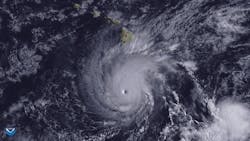As Hawaii prepared for Hurricane Lane, it’s likely building and facility managers in the area were preparing for the worst. The state closed government buildings, including public schools, in anticipation.
Had plans to visit Hawaii? Meetings Today shares what you can do about it.
Governor David Ige urged residents to be prepared to shelter in place with two weeks-worth of food, water and supplies. With strong winds and flooding expected, it could be the strongest hurricane to make landfall on Hawaii since Hurricane Iniki in 1992.
With that in mind, it’s important to have a disaster cleanup and business continuity plan in place before a hurricane approaches. Determine what level you want or need your building to function following a disaster. Crissa Hiranaga, director of public relations for the Four Seasons Resort Maui, says guest and employee safety is top priority.
“As is the resort’s standard practice, we continue to closely monitor Hurricane Lane and are taking all necessary precautions with guest and employee security and safety as our top priority,” she says. “While we hope for the best, we always prepare for the worst. In the event that there is an emergency, the resort and the state are fully prepared.”
When Hurricane Maria made landfall in Puerto Rico on Sept. 20, 2017, as a Category 4 storm, many buildings weren’t prepared. That’s because Puerto Rico has different building codes, standards and enforcement than the mainland, according to Scott Nacheman, member of the property loss consulting team at DeSimone Consulting Engineers.
Local Culture Decides Code Enforcement
Most recovery efforts are driven by company culture – or lack thereof, Nacheman notes. In his experience, international corporations that have a presence in hurricane- or disaster-prone areas have a more proactive resilience plan in place. In Puerto Rico, buildings weren’t built to the same standards that would be found on the mainland.
Related: Hurricane Health and Safety
“Ultimately it comes down to the local culture and what the building industry and commercial element in those parts of the world comply with,” he says.
In Hurricane Maria recovery efforts in Puerto Rico, many buildings are rebuilt to code. Enforcement is difficult because there aren’t as robust enforcement procedures in U.S. territories as there are in the states. This could lead to cutting corners in recovery efforts.
“That might not be noticed until there’s an extreme event like a storm and your building doesn’t perform like it should,” Nacheman says.
A building code is an “absolute minimum level of performance a building needs to adhere to,” he explains. “In most cases it’s not ensuring – or even suggesting – that your building will be functional following an event like a hurricane, tornado or earthquake. It only means it won’t fail during the event and people can get out safely.”
Build Beyond for Business Continuity
Building owners – focusing on Hurricane Maria recovery efforts or disaster cleanup – who want to maintain building continuity have to build beyond code requirements. Nacheman suggests owners look at best practices for:
- Building structure
- Building envelope
- Life safety systems
That way building owners and facility managers can maintain business continuity after an incident, he says. “Owners and operators need to be willing to invest in a more robust and resilient building to withstand greater forces to recover from loss of service” if they would like to maintain operations following a hurricane or other disaster.
Hand-picked: Beef Up Business Continuity Plan
Building owners and facility managers should determine initial priorities (e.g. keep the building dry, begin operation again, etc.) if disaster cleanup is necessary. Going to a performance-based design approach would allow for better performance of buildings after incidents, Nacheman suggests.
“Looking at the use and systems of the building would tell how systems would work and interact or not interact after an incident,” he says. He suggests moving away from the prescriptive methods that most building code entail toward performance systems similar to those that found in seismic design and other life safety systems.
Dry the Building in Disaster Cleanup
If a hurricane or other incident has occurred and disaster cleanup is necessary, owners and managers need to first focus on restoration of the building envelope and utilities. “If you can’t get the building closed in and drying, the damage to your building will grow exponentially over time,” Nacheman says. To get up and running quicker, he suggests having:
- A plan for pre-loss preparation to restore building envelope integrity
- A system in place to restore power generation and fuel for the systems
- Agreements with your insurance carrier to have an emergency restoration company available to perform dry down
For the third point, Nacheman emphasizes having a discussion with your insurance broker or carrier ahead of disaster cleanup about pre-approval of certain vendors and having accounts with those vendors for a quick response.
weeks after Hurricane María devastated the entire island.
Get an agreement that includes what vendors will be used, rates, level of work based on a given event and any other specific details that can be determined beforehand. All stakeholders should be aware of expectations before an incident so the response can move quickly.
The Federal Emergency Management Agency also suggests the following tips for facility preparation:
- Develop a preparedness program to help identify ways to protect facilities, physical assets and electronic information. Be sure to engage people with disabilities and access and functional needs in your emergency planning.
- Create a communications plan to keep in contact with customers, suppliers and employees during and after a storm. Be prepared to provide employees with information on when, if and how to report to work following an emergency. Consider those instances where telecommuting would be an option.
- Keep copies of important records such as building plans, insurance policies, employee contact information, bank accounts, computer backups and other priority documents in a waterproof container. Store a second set of records at an off-site location.
Once disaster strikes, access to supplies for disaster cleanup can be difficult. If the disaster hits an island, as Hurricane Maria did in Puerto Rico, it adds another layer of difficulty. It can make it more difficult to receive materials, find work crews available on the island or find housing for workers coming from elsewhere.
Read also: Summer Flood Tips
The logistics are massive in these cases, adding to delays in and increased cost of restoration, Nacheman notes. “If you can maintain utilities, water and communication, it goes a long way for allowing personnel to keep working in a somewhat safe environment,” he says.
This article was first published on June 15, 2018 and was updated on August 23, 2018. Staff writer Sarah Kloepple contributed to this article.
About the Author

Valerie Dennis Craven
Content strategist and writer
Valerie Dennis Craven is an experienced writer of commercial and residential buildings and interiors, having previously served as Editorial Director for both BUILDINGS and i+s. Valerie enjoys writing about technology and how it impacts users in the built environment.
